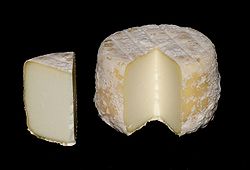- Crottin de Chavignol
-
Crottin de Chavignol 
Country of origin France Region, town Loire, Chavignol Source of milk Goats Pasteurised No Texture Soft-ripened, crumbly Aging time at least 4 weeks Certification French AOC 1976 Crottin de Chavignol is the most famous goat cheese of the many varieties produced in the Loire Valley. This cheese is the claim to fame for the village of Chavignol, France, which has only two hundred inhabitants.
Contents
History
The small cylindrical goat cheese from the area around Chavignol has been produced since the 16th century, but it wasn't until 1829 that it was first written about. The etymology is dubious: the word "Crot" described a small oil lamp made from burned clay, which resembles the mold used to prepare the cheese. Another explanation is that old "Crottin" gets harder and browner and tends to look like dung, the French word for an animal dropping being "crotte".
Quality control
Protected by the AOC Seal, Crottin de Chavignol is produced today with traditional methods. If a cheese is found at a cheese counter labeled "Crottin", it is of the Crottin type, but to be labeled "Crottin de Chavignol", it has to be from the area around Chavignol, and it has to meet the stringent AOC production criteria.
Flavour
The flavour of Crottin de Chavignol is subtle and slightly nutty. In its youth, its dough is solid and compact, and its rind is white. As it ripens, the dough becomes crumbly and the mould on the rind matures into a bluish colour. The bluish colour doesn't mean that the cheese is no longer edible - quite the opposite.
Recipes
A classic dish is baked Crottin de Chavignol on a green salad. The dish is said to go well with a Sancerre wine from its home region.
A non-AOC imitation called "Crottin de Champcol" is also available.
References
External links
Categories:- French cheeses
- French products with protected designation of origin
- Goat's-milk cheeses
Wikimedia Foundation. 2010.

